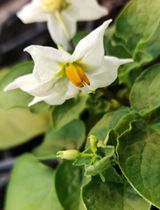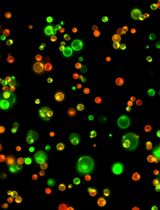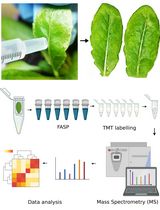- EN - English
- CN - 中文
A Fast and Easy Method to Study Ralstonia solanacearum Virulence upon Transient Gene Expression or Gene Silencing in Nicotiana benthamiana Leaves
利用本生烟叶片基因瞬时表达或沉默研究青枯菌毒力的快速简便方法
发布: 2021年08月05日第11卷第15期 DOI: 10.21769/BioProtoc.4116 浏览次数: 4534
评审: Tohir A. BozorovAnonymous reviewer(s)
Abstract
Ralstonia solanacearum is a devastating soil-borne bacterial pathogen that causes disease in multiple host plants worldwide. Typical assays to measure virulence of R. solanacearum in laboratory conditions rely on soil-drenching inoculation followed by observation and scoring of disease symptoms. Here, we describe a novel inoculation protocol to analyze the replication of R. solanacearum upon infiltration into the leaves of Nicotiana benthamiana, in which gene expression has been altered using Agrobacterium tumefaciens. The protocol includes five major steps: 1) growth of N. benthamiana plants; 2) infiltration of A. tumefaciens; 3) R. solanacearum inoculation; 4) sample collection and bacterial quantitation; 5) data analysis and representation. The transient gene expression or gene silencing prior to R. solanacearum inoculation provides a straightforward way to perform genetic analysis of plant functions involved in the interaction between pathogen and host, using the appropriate combination of A. tumefaciens and R. solanacearum strains, with high sensitivity and accuracy provided by the quantitation of bacterial numbers in plant tissues.
Keywords: Ralstonia solanacearum (青枯病菌)Background
Ralstonia solanacearum is considered one of the most destructive bacterial pathogens in plants worldwide due to its aggressiveness and wide host range. R. solanacearum invades host plants through their roots and colonizes their xylem vessels, finally spreading through the whole plant and leading to bacteria wilt disease (Xue et al., 2020). R. solanacearum is able to infect more than 250 plant species and is particularly well-adapted to infecting crops from the Solanaceae family, including tomato, potato, tobacco, eggplant, and other economically important crops (Mansfield et al., 2012). Experimental assays to assess the virulence of R. solanacearum in Solanaceae plants under laboratory conditions mostly rely on soil-drenching inoculation with a bacterial suspension followed by observation of disease symptoms (Morel et al., 2018). Other methods are based on the injection or infiltration of the bacterial suspension directly into the stems or leaves, bypassing the root penetration process and allowing a more sensitive and accurate quantitation of bacterial numbers in plant tissues (Morel et al., 2018). These methods have been extensively used to compare the virulence of different R. solanacearum strains in Solanaceae plants; however, the analysis of different plant genotypes relies on the availability of relevant plant mutants or transgenic plants, or otherwise requires their generation, which is usually time-consuming. We recently developed a method to generate tomato plants with transgenic roots suitable for subsequent soil-drenching inoculation with R. solanacearum, which allows for the faster generation of transgenic root material to study root invasion and the subsequent generation of disease symptoms (Morcillo et al., 2020). However, this method does not allow for accurate quantitation of bacterial replication in plant tissues. Nicotiana benthamiana, a model plant from the Solanaceae family, is well known for its suitability for transient gene expression mediated by Agrobacterium tumefaciens (Li, 2011). Therefore, we envisioned a straightforward procedure to manipulate gene expression in N. benthamiana tissues using A. tumefaciens followed by the subsequent infiltration of R. solanacearum and quantitation of R. solanacearum replication over time. Such a method should overcome two major issues: (i) many R. solanacearum strains, including the reference GMI1000 strain, are not virulent in N. benthamiana due to the recognition of two effector proteins (AvrAA and RipP1) by the immune system of this plant species (Poueymiro et al., 2009); and (ii) the inoculated R. solanacearum strain should be differentiated from the A. tumefaciens population previously infiltrated into the same leaf tissues. To overcome the first issue, we used the R. solanacearum Y45 strain, which was originally isolated from tobacco plants (Li et al., 2011) and lacks both AvrAA and RipP1, allowing it to replicate effectively in N. benthamiana leaf tissue (Sang et al., 2020). To circumvent the second issue, we transformed R. solanacearum Y45 with a plasmid that confers resistance to the antibiotic tetracycline to allow the selection of R. solanacearum Y45 colonies in solid medium while avoiding growth of A. tumefaciens. This simple method can be used to accurately determine R. solanacearum virulence in N. benthamiana tissues expressing heterologous genes (Sang et al., 2020; Wei et al., 2020), overexpressing endogenous genes, or undergoing gene silencing mediated by RNAi. The versatility of this method allows the study of bacterial virulence factors in plant tissues by expressing them in plant cells prior to bacterial inoculation, as well as genetic analysis of the contribution of plant genes to disease resistance or susceptibility.
Materials and Reagents
Conical centrifuge tubes (50 ml) (GeneBrick, catalog number: GP0-7500)
Microcentrifuge tubes (1.5 ml) (BBI, catalog number: F600620-0001)
Needleless syringes (1 ml)
Plastic Petri dishes (90 mm diameter)
Pipette tips (AIBIO, catalog number: T1040000)
Paper towels
Cork borer (Integra Miltex, model: 33-34-P/25)
(Optional) Sprial counting grid (90 mm diameter) (Interscience, Easysprial®, catalog number: 413014)
Metal beads
Spectrophotometer plastic cuvettes (BRAND, catalog number: 759015)
Syringe filters (0.45 μm) (Millex, Millex®-HV, catalog number: SLHV033RB)
Distilled sterile water
75% ethanol (Sinopharm Chemical Reagent, SCR®, catalog number: 801769610)
Triphenyltetrazolium chloride (TTC) (Sigma-Aldrich, catalog number: T8877-5G)
Glucose (Sinopharm Chemical Reagent, SCR®, catalog number: 63005518)
Bacto peptone (BD, catalog number: 211677)
Yeast extract (OXOID, catalog number: LP0021)
Casein hydrolysate (Casamino acids) (Sigma-Aldrich, catalog number: 22090-500G)
Agar (Sinopharm Chemical Reagent, SCR®, catalog number: 10000561)
Tryptone (OXOID, catalog number: LP0042)
Sodium chloride (NaCl) (Sinopharm Chemical Reagent, SCR®, catalog number: 10019318)
3’,5’-Dimethoxy-4’-hydroxyacetophenone (AS) (Sigma-Aldrich, catalog number: 2478-38-8)
Magnesium chloride hexahydrate (MgCl2·6H2O) (Sinopharm Chemical Reagent, SCR®, catalog number: 10012818)
Potassium hydroxide (KOH) (Sinopharm Chemical Reagent, SCR®, catalog number: 10017018)
MES free acid monohydrate (MES) (Amresco, catalog number: Amresco E169)
Dimethyl sulfoxide (DMSO) (Diamond, catalog number: A100231-0500)
Standard potting soil (Pindstrup, catalog number: 1034593214)
Tetracycline hydrochloride (Sangon Biotech, catalog number: T0422)
Vermiculite
Phi medium (see Recipes)
1% (W/V) TTC solution (see Recipes)
20% (W/V) glucose solution (see Recipes)
Agrobacterium infiltration buffer (see Recipes)
LB medium (see Recipes)
Tetracycline hydrochloride (optional, depending on the antibiotic resistance of the strains used) (see Recipes)
Equipment
Tweezers
Scissors
Medium- and high-throughput tissue grinder (QIAGEN, model: Tissue Lyser II)
NanoDrop spectrophotometer (Thermo Scientific, model: NanoDrop 2000c)
Water distiller/sterilizer (Millipore, model: Mili-Q intergral 10L)
Spiral plater (optional) (Interscience, Easysprial®, catalog number: 412000)
Vortex (Scientific Industries, model: Vortex-Genie 2, catalog number: S1-0246)
(Optional) Alcohol lamp
Petri dish incubator at 28°C (Panasonic, model: MIR-262-PC)
Autoclave (SANYO, model: MLS-3780)
Flow hood (clean bench) (Shanghaishangjing, model: CA-1390-1)
Plant growth chamber (Percival, model: I-36VL)
Electronic balance (Sartorius, model: BSA224S)
Centrifuge (Eppendorf, model: centrifuge 5424)
pH meter (Sartorius, model: PB-10)
Tube incubator (shaker) at 28°C (Eppendorf, New BrunswickTM, catalog number: m1324-0006)
Software
GraphPad Prism 7 (GraphPad, http://www.graphpad.com), or equivalent program for statistical analysis
Microsoft Excel (Microsoft), or equivalent spreadsheet calculation program
Procedure
文章信息
版权信息
© 2021 The Authors; exclusive licensee Bio-protocol LLC.
如何引用
Yu, W. and Macho, A. P. (2021). A Fast and Easy Method to Study Ralstonia solanacearum Virulence upon Transient Gene Expression or Gene Silencing in Nicotiana benthamiana Leaves. Bio-protocol 11(15): e4116. DOI: 10.21769/BioProtoc.4116.
分类
植物科学 > 植物分子生物学 > 蛋白质
植物科学 > 植物生理学 > 生物胁迫
分子生物学 > DNA > 转化
您对这篇实验方法有问题吗?
在此处发布您的问题,我们将邀请本文作者来回答。同时,我们会将您的问题发布到Bio-protocol Exchange,以便寻求社区成员的帮助。
提问指南
+ 问题描述
写下详细的问题描述,包括所有有助于他人回答您问题的信息(例如实验过程、条件和相关图像等)。
Share
Bluesky
X
Copy link












